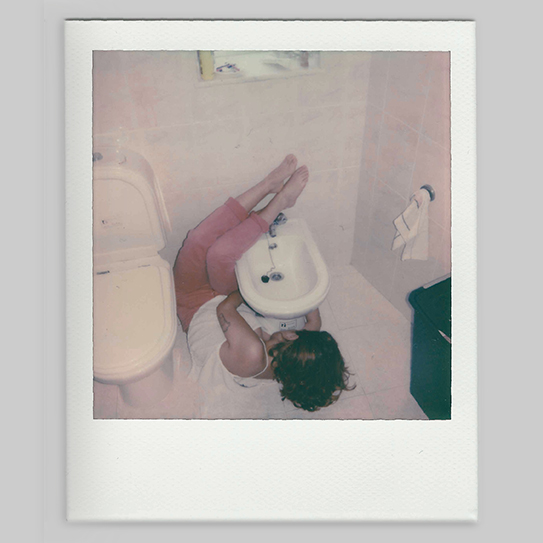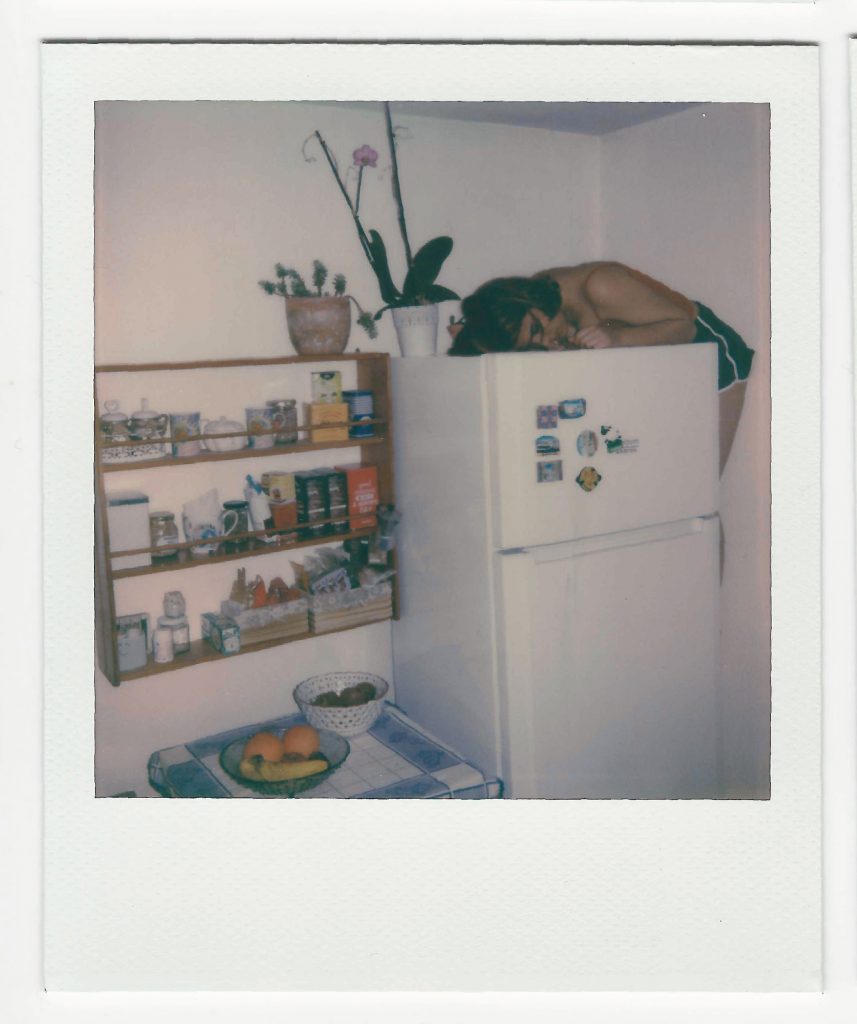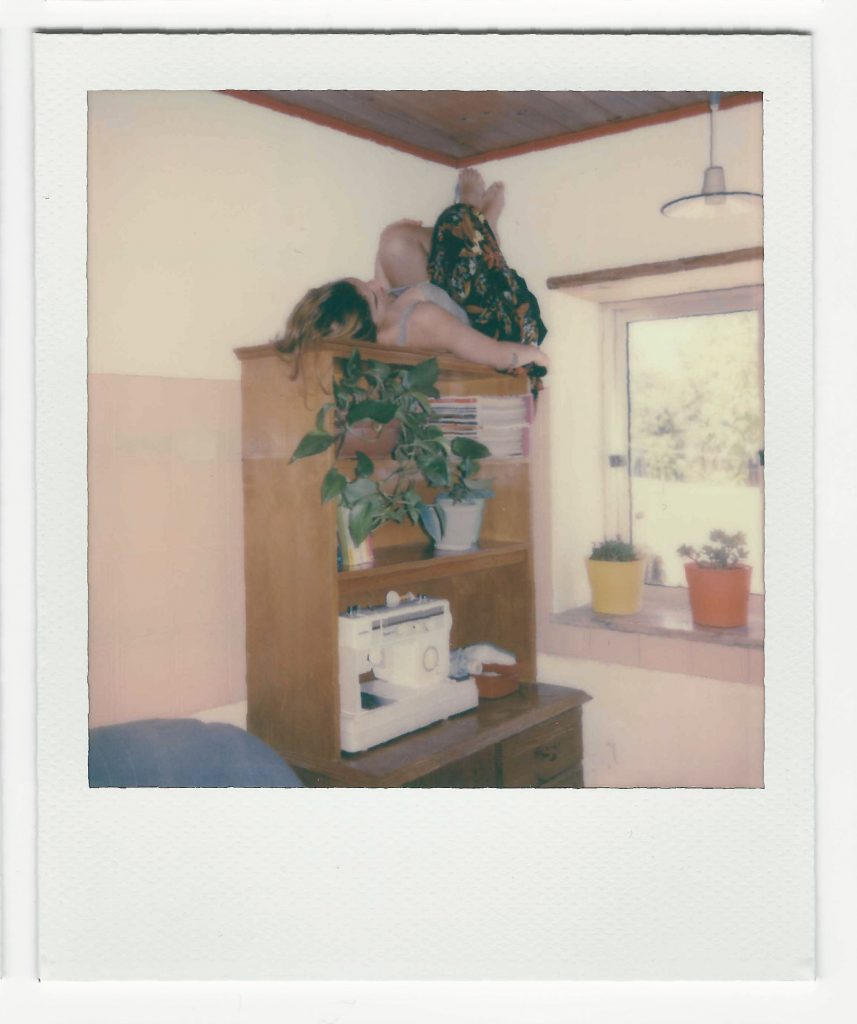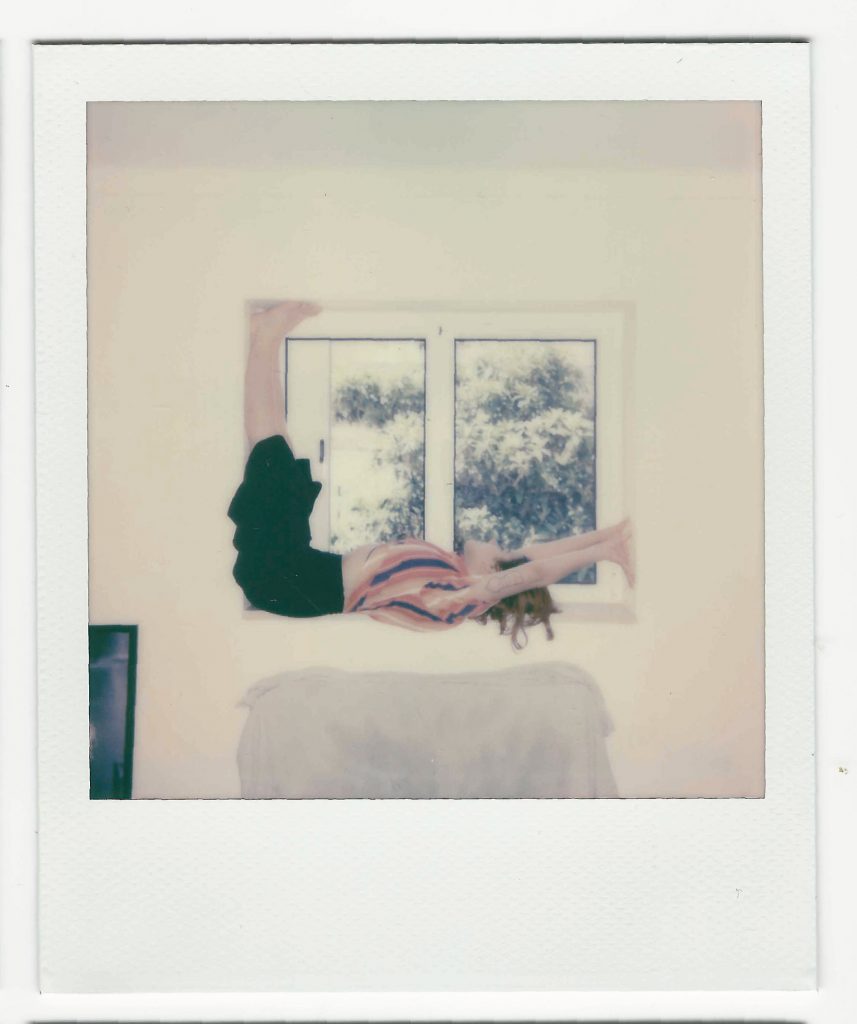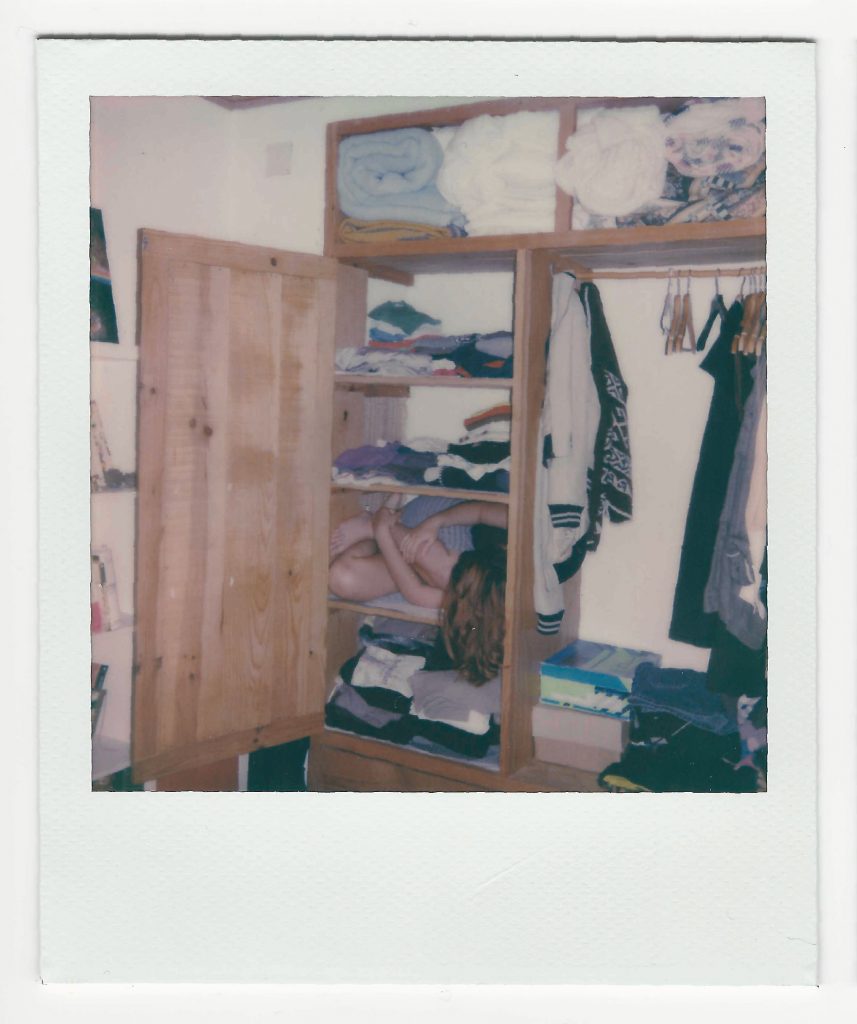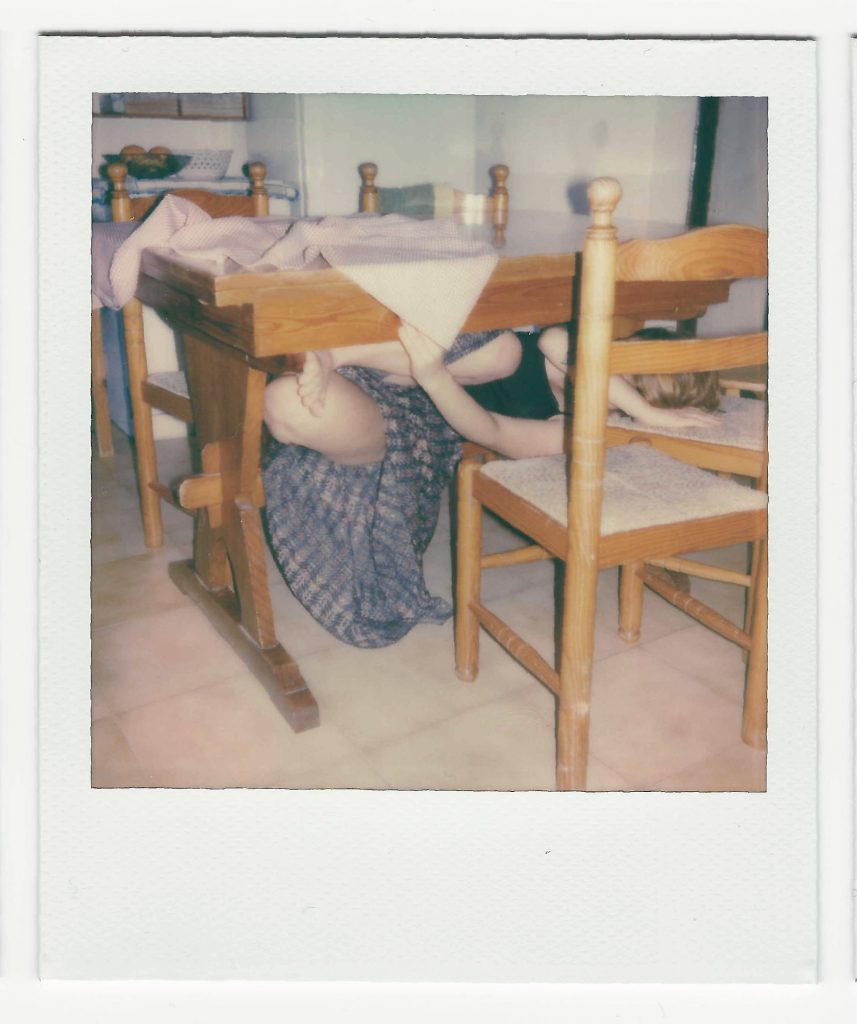Como o Corpo Ocupa
Aurora Amado
Fotografia instantânea
9 fotografias
8,8X10,7cm
Este trabalho é constituído por um conjunto de nove fotografias instantâneas, que foram digitalizadas para apresentação.
[PT]
A estranha realidade com que todos inevitavelmente nos confrontámos, que lentamente se assimilou, tornando-se numa nova norma, transformou as prévias estruturas sociais, que regiam a nossa ação diária, em novas, resultado da necessidade de construir uma nova consciência sobre o “existir”. Imposto o confinamento, e o consequente isolamento social, a esfera pública foi anulada, sendo o espaço de ocupação restrito à habitação. Esta reparte-se nas suas funções e alberga diferentes necessidades dos ocupantes que não correspondem ao prévio paradigma da casa. A incorporação de multifacetadas vivências, neste único e restrito espaço, que não lhe pertenciam, transformou-o, não exclusivamente, mas inevitavelmente, num local de produção artística.
Apesar do plano de ação do indivíduo ser progressivamente digital, superando as limitações materiais do corpo através de diversas extensões e prolongamentos incorpóreos (que notoriamente se salienta no estado corrente), não consegui escapar à reflexão sobre aparato físico em que todos nós existimos e a subsequente fragilidade e mutabilidade do espaço que ocupo.
Assim, a obrigação de funcionar consoante esta nova dinâmica de trabalho e vida, que em nada se relacionava com o anterior, entende uma revisão da minha relação com o meu lar, cujas restrições se tornavam crescentemente difíceis de ignorar. Com o passar do tempo, o espaço que habito aparenta fechar-se diante mim, revelando-se sufocante. As barreiras que certos espaços impingem sobre o bemestar pessoal que se tornam incontornáveis quando não existe nenhum outro lugar passível de ocupação servem de incentivo para uma exploração artística que se resolve em torno do corpo como elemento central num processo que reafirmasse a matéria do artista e do próprio objeto artístico.
Movimentamo-nos pelos percursos determinados pela arquitetura, pelas peculiaridades de cada divisão e dos diferentes objetos e mobília que as ocupam. Aceitamos ser guiados por estas massas estáveis, que se apresentam com restritas funcionalidades às quais nos sujeitamos. Vivemos conformados com estas limitações, que não permitem explorar outras potencias do espaço, que se gere de acordo com as dinâmicas do seu conteúdo e respetiva. Uma casa, um quarto ou uma cadeira, coisas com as quais nos relacionamos com grande familiaridade, por vezes podem demonstrar facetas que nos são desconhecidas, distantes. Não ocupamos estas reentrâncias, cantos, buracos vazios entre cada móvel e a estrutura, ou os intencionais vazios que existem somente para o serem. São espaços nulos que apreendemos com indiferença e desinteresse, que apropriei como ferramentas para abordar a minha relação com a casa, na qual os mesmos pertencem.
O meu corpo investiga, através de tentativa e erro, as possibilidades de movimentação pelo vasto vazio inexplorado a que nunca teve acesso, ou se o teve, somente em criança, quando a condição do funcional não se aplicava à nossa escala e não regia os gestos. Uma nova apreensão da realidade permite a criação de novas perspetivas sobre a casa, nova informação é adquirida e novas memórias são formadas
do espaço assim como do corpo. Da interação de ambos resultam situações nas quais o corpo se confronta com desconforto e esforço e ausência de liberdade motora que revelam as dificuldades inerente na relação dos dois
Destes momentos performáticos muito pessoais resulta, para um público distante, o registo fotográfico. As pequenas fotografias instantâneas permitem uma limitada apreensão do espaço que habito. Captam, sem aviso, a intimidade entre mim e a casa. A natureza instantânea deste registo acentua a efemeridade e autenticidade destes gestos de descoberta, e permitem também uma forte componente física ao objeto, a par que é explorada em cada uma das imagens.
Este processo de gênese performativa serviu de dispositivo para projetar a desconexão sentida na relação com o íntimo espaço familiar. No familiar, por vezes não se sente o que palavra evoca. A ocupação da própria casa nem sempre implica conforto, que contraria a tarefa que seria posta a seu encargo de atuar como um local de refúgio e salvaguardo. Tal desconforto manifestou-se nestes momentos registados; coloquei o meu corpo em circunstâncias que não deviam ser, abnormais. Procurei por estes lugares apertados, restritos, com os quais cada interação se tornou fatigante e desafiadora da normalidade. Desta forma evidenciasse a desconexão com o ambiente familiar através da dinâmica entre mim e o mesmo que contraria o expectável. Incapaz de solucionar a si mesmo nos diversos esforços de pertença, este corpo, que prevalece nas fotografias, apesar de se encaixar nos espaços, não é capaz de se introduzir na normalidade. Tornou-se imperativa uma tentativa de fuga a esta claustrofobia, que não parece suscetível à mudança pois mesmo quando desafiada pela procura destes “novos” esconderijos, onde me tentei libertar, somente se revelaram os grandes condicionamentos presentes no interior destas estruturas de intimidade a que chamamos de casa.
[EN]
The strange reality with which we all inevitably found ourselves confronted with, was slowly assimilated, becoming the norm. The previous social structures that governed our daily actions, transformed in new, resulting on the need to build a new awareness about existing. Enclosed against our desires and isolated from society the public sphere was nullified making the home the only space available for living. The house reassigns herself to accommodate the different necessities of its occupants that do not correspond with its original paradigm. The incorporation of multifaceted ways of being in this one and only restricted space, that previously did not belong there, transformed it in a place for artistic production, amongst others.
The framework for the action of the individual is growingly becoming digitalized, surpassing the material limitations of the body resorting on various incorporeal extensions, that becomes more obvious in the current state of things. Despite this I could not escape to pounder about the physical quality of a body that we all share and the intertwining fragility and changing nature of the space I occupy. Therefore, the obligation of functioning according this new dynamic of work and living entails a reform of my understanding of my own relationship with home, that entails restrictions increasingly hard to ignore. With the passage of time the space I live in seems to close on me, revealing its suffocating nature. The barriers that certain spaces inflict on the personal wellbeing that become unescapable when there is no were else to go, cannot be forgotten. These implications adjoined to the space serves as incentive for an
artistic exploration that resolves itself around the body, that is the central element of this process which reaffirms the materiality of the artist and the artistic object.
We move through routes determined by the architecture, by the peculiarity of each division and of the different objects and furniture that fill it. We accept being guided by these stable masses that present themselves with restrict functionalities to which we subject ourselves. Conformed by this limitation that does not allow exploration of other potentials present in the space that limits itself according to its function. A house, a room or a chair, things with which we interact with great familiarity sometimes can have different dimensions that are unknown to us. There is a lack of occupation of such places, these corners, and empty holes between furniture and structures or the intentional emptiness that exist just to be so. Null spaces apprehended with indifference and uninterest that I appropriated as a mean to approach my relationship with the house in which they also belong.
My body investigates, thought trial and error, the possibilities of moving in the vast and unexploited that it never had access to, or if it did, it was has a child, when the condition of the functional did not applied to our scale and didn’t conduct our gesture. A new spatial apprehension of this reality allows for the creation of new perspectives on the house, new information is acquired, and new memories are formed about the space and about the body. The interaction between both results in situations where the body is confronted with effort or absent of freedom in his movements that reveal the difficulty in the relationship between the two.
From these very personal performance-based moments ensue, for the distant audience, a photographic register. The self-developing film used for the capture of the moments allow for a small understanding of the space I inhabit; they capture without warning the intimacy between me and the house. The nature this picture enhances the ephemerality and authenticity of this gesture of discovery and allows for a strong physicality to the object that matches the one in each image.
This process that originates from a performative action served has device to work the disconnection preset in the relationship with the intimate family space. The occupation of my own house does not always mean a comfortable experience contradicting the intent for a home as a safe harbor. Such discomfort display itself in the capture moments, I placed my body in circumstances that should not be. I searched for these tight and restricted spaces with which the interaction became tiring and challenging of the normality to put in evidence the disconnection to the family environment by contradicting expectation. Unable to resolve itself with these different efforts of belonging, the body that permeates the pictures, despite fitting in these small spaces, does is unable to fit within the normality. It became imperative to attempt to escape the claustrophobia that does not seem able to chance even when in search of “new” hiding places where I tried do free myself but only unfold the big constraints present in the interior of these structures we call home.
